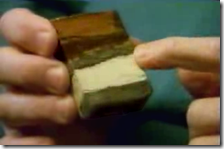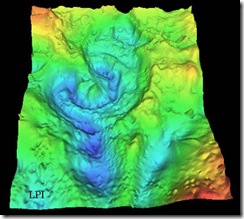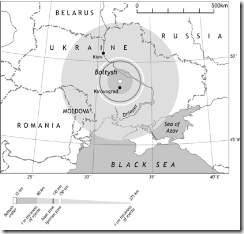The idea that the death of the dinosaurs was caused by a meteorite impact first surfaced in 1980 – and captured my imagination. Now there has been a new development.
 This highly controversial hypothesis was based on the discovery by physicist Luis Alvarez and his team found an identical geological signature in sedimentary rocks all over the world - a thin layer of rock containing abnormally high concentrations of Iridium. This layer marks the K-T boundary between the Cretaceous and Tertiary ages which was the time when the known mass extinction of life occurred. Iridium is very rare on Earth but abundant in asteroids and comets. Hence the idea that life was extinguished by an extraterrestrial object impacting on the earth.
This highly controversial hypothesis was based on the discovery by physicist Luis Alvarez and his team found an identical geological signature in sedimentary rocks all over the world - a thin layer of rock containing abnormally high concentrations of Iridium. This layer marks the K-T boundary between the Cretaceous and Tertiary ages which was the time when the known mass extinction of life occurred. Iridium is very rare on Earth but abundant in asteroids and comets. Hence the idea that life was extinguished by an extraterrestrial object impacting on the earth.
The following year, a University of Arizona grad student Alan R Hildebrand and his faculty adviser William V Boynton published a draft Earth-impact theory and began looking for a candidate crater which their evidence suggested should be in the Caribbean basin.
They were completely unaware that, the very same year, geophysicist Glen Penfield had presented a paper at the 1981 Society of Exploration Geophysicists conference which provided evidence of a large impact crater off the coast of Yucatan. Penfield has been prevented by Pemex, the oil company he worked for, from obtaining rock cores or other physical evidence so his case rested entirely on geophysical data sets. in addition, the conference was underattended and the report attracted little attention.
Hildebrand first learned of Penfield’s discovery from a Houston Chronicle reporter in 1990. Through their joint efforts, they succeeded on obtaining drill samples from the site which provided the hard evidence they needed.
 A 3D map of local gravity and magnetic field variations reveals the Chicxulub crater, now buried beneath tons of sediment. This view is looking down at the surface, from an angle of about 60°.
A 3D map of local gravity and magnetic field variations reveals the Chicxulub crater, now buried beneath tons of sediment. This view is looking down at the surface, from an angle of about 60°.
The Chicxulub crater, as it is now known, is buried under the Yucatan Peninsula and the ocean. The crater is more than 180 km (110 mi) in diameter, and is the second largest impact structure on earth.
It has been calculated that the 15km-wide asteroid that made it was travelling at 20km a second when it struck the Earth with a force a billion times greater than the Hiroshima bomb.
Wikepdia reports that: ‘In March 2010, following extensive analysis of the available evidence covering 20 years' worth of data spanning the fields of palaeontology, geochemistry, climate modelling, geophysics and sedimentology, 41 international experts from 33 institutions reviewed available evidence and concluded that the impact at Chicxulub triggered the mass extinctions during K-T boundary including those of dinosaurs.’
Source: The Boltysh Meteorite Impact Crater Project
Now a new study of a meteorite impact crater at Boltysh in the Ukraine suggests a different scenario. First discovered in 1990, it has only recently been reliably dated and is now believed to have been created several thousand years before Chicxulub.
This suggests that the mass extinction of life that occurred at the end of the Cretaceous era may have been driven by multiple meteor strikes over a long period.
[See full story at Double meteorite strike 'caused dinosaur extinction' By Howard Falcon-Lang. Science reporter, BBC News. 27th August]
SPACEGUARD
The Spaceguard Central Node, the web site of The Spaceguard Foundation and of the Spaceguard System, is freely opened to all people wishing to understand what is being done for observing and tracking Near-Earth Objects (NEOs): asteroids and comets that could represent a threat to the Earth's ecosystem in case of an impact.


No comments:
Post a Comment